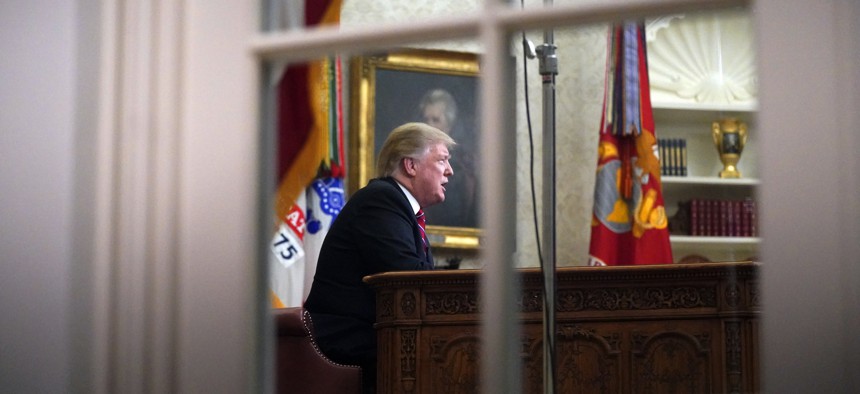
As seen from a window outside the Oval Office, President Donald Trump gives a prime-time address about border security Tuesday, Jan. 8, 2018, at the White House in Washington. AP Photo/Carolyn Kaster
Why Trump Is Trying to Create a Crisis
The president didn’t declare a state of national emergency on Tuesday night, but he laid the foundation for doing so.
Donald Trump devoted remarkably little of his Tuesday-night Oval Office address to persuading Americans to support a border wall. He discussed his beloved barrier for only a few sentences and didn’t rebut any of the criticisms commonly leveled at it. He never explained how the federal government would take possession of the land needed to build the wall, why migrants wouldn’t be able to climb over or dig under it, or even how much of the border it would actually cover.
This inattention fits a pattern. Trump has never shown much interest in actually building a wall. Last January, over cheeseburgers at the White House, Chuck Schumer agreed to fund Trump’s wall in exchange for legalizing the undocumented “dreamers” who had come to the United States as children. But Trump dashed the deal by demanding cuts in legal immigration. Then, the following month, 54 senators—including all but three Democrats—voted for a bill to provide $25 billion for border security over 10 years, including “physical barriers” and “fencing,” along with protections for the dreamers. But the White House spurned that legislation in favor of an enforcement-only bill that had no chance of passage. Nonetheless, Senator Patrick Leahy of Vermont, the top Democrat on the Senate Appropriations Committee, recently noted that over the past two years, Congress has in fact “provided nearly $1.7 billion to build or replace fencing on the southern border.” The administration has spent only 6 percent of those funds.
The real purpose of Trump’s speech wasn’t to persuade Americans to support a wall. It was to convince them that America faces an immigration “crisis.” He used the word in his first sentence, and then an additional five times. And most of his speech was a catalog of horrors, a collection of reasons that, because of illegal immigration, Americans should lock themselves inside their houses and pray to make it through the night.
Related: In Primetime Addresses, Trump and Democrats Show No Progress Toward Ending Shutdown
Related: White House Expands Border Troops’ Authorities, Raising Questions
Related: What Trump Could Do If He Declares a State of Emergency
After blaming undocumented immigrants for the fact that “more Americans will die from drugs this year than were killed in the entire Vietnam War,” Trump went on to declare that ice officers had apprehended migrants charged with “30,000 sex crimes and 4,000 violent killings.” Later, he told his audience about the “young policeman … savagely murdered in cold blood by an illegal alien,” the “Air Force veteran … raped, murdered, and beaten to death with a hammer by an illegal alien,” the “illegal alien … charged with murder for killing, beheading, and dismembering his neighbor,” and the “MS-13 gang members … charged last year after viciously stabbing and beating a 16-year-old girl.” Trump punctuated these stories by demanding that the Democrats stop allowing Americans “to be so horribly victimized” and by asking, “How much more American blood must we shed before Congress does its job?” How a border wall would stop all this carnage, he never really explained.
This is the Trump way. In 2016, he began his convention acceptance speech by declaring, “Our convention occurs at a moment of crisis for our nation. The attacks on our police, and the terrorism in our cities, threaten our very way of life.” He went on to discuss police officers “brutally executed,” the “men, women, and children viciously mowed down” by terrorists, and the various Americans “brutally murdered” by undocumented immigrants.
In that speech, too, Trump said little substantive about how he would solve these problems. But that wasn’t the point. The point was that America’s crises were so grave, and the threats it faced so terrifying, that Americans had to turn away from traditional politicians and jettison their normal ways of governing. When Trump endorsed torture, proposed a ban on Muslim immigration, and demanded “extreme vetting,” and now, when he floats the idea of a national emergency, he is saying that only he can take the extreme measures necessary to answer America’s extreme threats. In a December 2017 poll, two-thirds of Trump’s strongest supporters told the Public Religion Research Institute, “Because things have gotten so far off track in this country, we need a leader who is willing to break some rules.”
Trump’s strategy of depicting America as a nation on the brink of catastrophe and awash in blood is unlikely to make congressional Democrats cave on the government shutdown. But it has its advantages. It primes Trump’s base to support whatever rule-breaking, extra-constitutional behavior he decides to pursue, and thus pressures Washington Republicans to swallow his transgressions or else risk a backlash from the GOP base. Trump didn’t declare a state of national emergency on Tuesday night, but he offered a rationale for doing so.
That’s the advantage of declaring America to be in perpetual crisis. It means that when you’re not winning by the normal rules, you give yourself the option to break them. Trump may lose the shutdown fight. But two years into his presidency, nobody truly knows how many rules he will be willing to break in order to ensure that he triumphs in the end.
NEXT STORY: Moscow’s Little-Noticed Islamic-Outreach Effort
